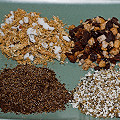Q: About designing planting mixes.

Special mixes
A: When creating a planting mix, think about what you want to achieve.
Do you want an acidic mix or a neutral one? Do you want plenty of aeration
or a dense, waterlogged mix? Do you want a coarse or a fine mix? Review the attributes of each of these
in the previous FAQ pages, then select
your ingredients to provide the desired effects. This is where the art is, and where things get interesting!
Charcoal may have some chemically active properties, but I do not
really believe it. In terms of its physical structure, it is an aggregate.
Gravel is similar to perlite, but is much denser.
Peat provides water retention, but not much aeration. It is
very acidic, but eventually breaks down.
Perlite provides excellent drainage and an airy mix. Large chunk perlite it is
too coarse for tiny plants, so select the grain size wisely.
Pumice is similar to perlite, but heavier.
Sand (Silica-based) provides good drainage, but smooth-grained kinds can lock out air.
Sand (Calcium carbonate-based) creates a well-drained, alkaline medium.
Sphagnum (live) provides water retention and is very acidic, but most species are
coarsely grained and not suitable for tiny plants. It is excellent for rooting plants, and tempermental
Nepenthes and Darlingtonia, but can be tempermental itself!
Sphagnum (long-fiber) provides water retention and is very acidic, but is coarsely
grained and not suitable for tiny plants. It is also expensive (financially and
environmentally).
Sphagnum (milled) is like long-fiber Sphagnum, but is fine
grained.
Vermiculite is similar to peat but is not acidic. It breaks down.
Combine your ingredients to achieve the goals you desire. A tuberous
Drosera will want a sandy mix (perhaps 2 or 3 sand: 1 peat).
Sarracenia like pure Sphagnum or sand & peat.
Mexican Pinguicula
like a number of compounds---my usual mix for them is
3 perlite: 2 vermiculite, but I'm not very happy with it.
Some carnivorous plants (or at least their growers!)
prefer quite complicated planting mixes that involving any number of
the elements profiled in this FAQ in combination
with compost, Osmunda fiber, pine needles, oak leaves,
or other additives. Feel free to experiment and by all means
report your findings. Sadly, there are no solid, reliable recipes that seem
to work for everyone. I mention some of these mixes in the section of the
FAQ where I discuss each genus.
Page citations: Rice, B.A. 2006a; personal observation.